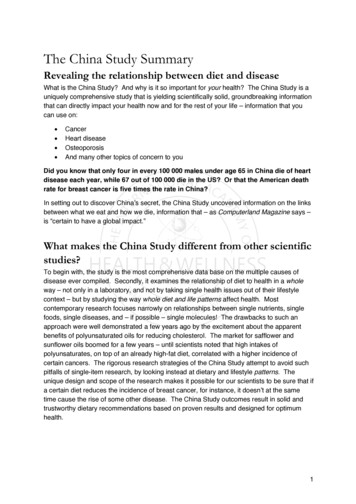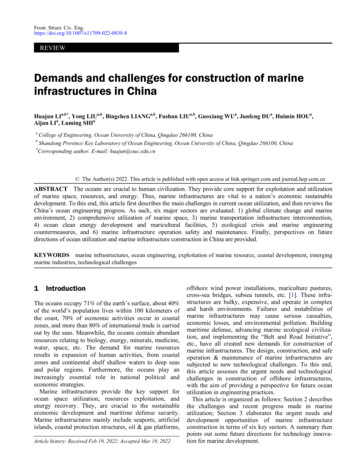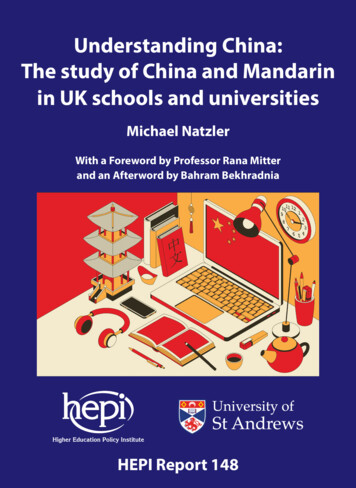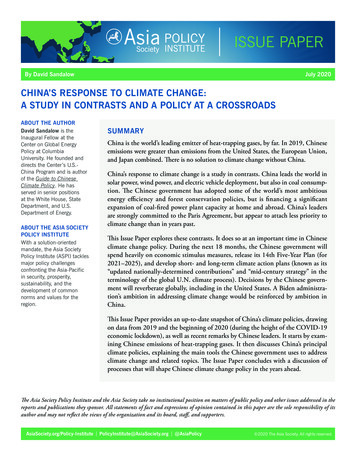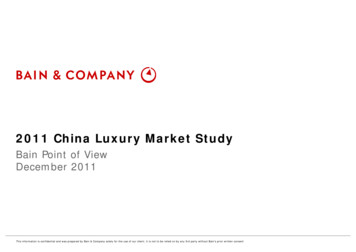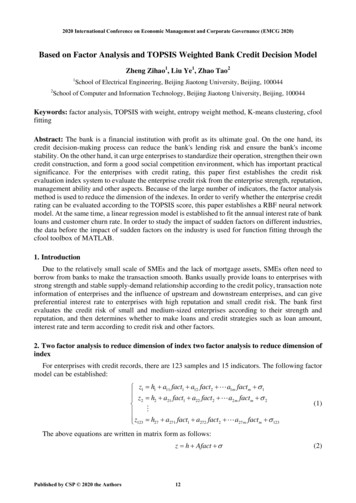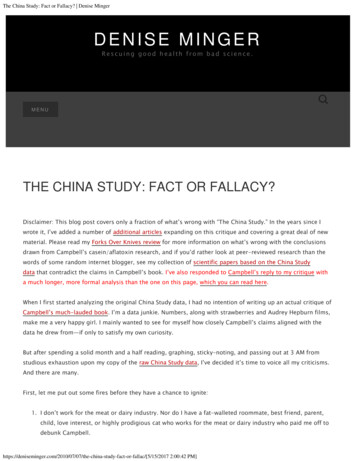
Transcription
The China Study: Fact or Fallacy? Denise MingerDENISE MINGERRescuing good health from bad science.Search MENUTHE CHINA STUDY: FACT OR FALLACY?Disclaimer: This blog post covers only a fraction of what’s wrong with “The China Study.” In the years since Iwrote it, I’ve added a number of additional articles expanding on this critique and covering a great deal of newmaterial. Please read my Forks Over Knives review for more information on what’s wrong with the conclusionsdrawn from Campbell’s casein/aflatoxin research, and if you’d rather look at peer-reviewed research than thewords of some random internet blogger, see my collection of scientific papers based on the China Studydata that contradict the claims in Campbell’s book. I’ve also responded to Campbell’s reply to my critique witha much longer, more formal analysis than the one on this page, which you can read here.When I first started analyzing the original China Study data, I had no intention of writing up an actual critique ofCampbell’s much-lauded book. I’m a data junkie. Numbers, along with strawberries and Audrey Hepburn films,make me a very happy girl. I mainly wanted to see for myself how closely Campbell’s claims aligned with thedata he drew from—if only to satisfy my own curiosity.But after spending a solid month and a half reading, graphing, sticky-noting, and passing out at 3 AM fromstudious exhaustion upon my copy of the raw China Study data, I’ve decided it’s time to voice all my criticisms.And there are many.First, let me put out some fires before they have a chance to ignite:1. I don’t work for the meat or dairy industry. Nor do I have a fat-walleted roommate, best friend, parent,child, love interest, or highly prodigious cat who works for the meat or dairy industry who paid me off todebunk hina-study-fact-or-fallac/[5/15/2017 2:00:42 PM]
The China Study: Fact or Fallacy? Denise Minger2. Due to food sensitivities, I don’t consume dairy myself, nor do I have any personal reason to promote itas a health food.3. I was a vegetarian/vegan for over a decade and have nothing but respect for those who choose a plantbased diet, even though I am no longer vegan. My goal, with the “The China Study” analysis andelsewhere, is to figure out the truth about nutrition and health without the interference of biases anddogma. I have no agenda to promote.As I mentioned, I’m airing my criticisms here; this won’t be a China Study love fest, or even a typical balancedreview with pros and cons. Campbell actually raises a number of points I wholeheartedly agree with—particularly in the “Why Haven’t You Heard This?” section of his book, where he exposes the reality behind BigPharma and the science industry at large. I admire Campbell’s philosophy towards nutritional research and echohis sentiments about the dangers of scientific reductionism. However, the internet is already flooded with ravereviews of this book, and I’m not interested in adding redundant praise. My intent is to highlight theweaknesses of “The China Study” and the potential errors in Campbell’s interpretation of the original data.(IMPORTANT NOTE: My response to Campbell’s reply, as well as to some common reader questions, can befound in the following post: My Response to Campbell. Please read this for clarification regarding univariatecorrelations and flaws in Campbell’s analytical methods.)(If this is your first time here, feel free to browse the earlier posts in the China Study category to get up tospeed.)On the Cornell University website (the institution that—along with Oxford University—spawned the ChinaProject), I came across an excellent summary of Campbell’s conclusions from the data. Although this article waspublished a few years before “The China Study,” it distills some of the book’s points in a concise, down-n’-dirtyway. In this post, I’ll be looking at these statements along with other overriding claims in “The China Study” andseeing whether they hold up under scrutiny—including an in-depth look at Campbell’s discoveries with casein.(Disclaimer: This post is long. Very long. If either your time or your attention span is short, you can scroll downto the bottom, where I summarize the 9,000 words that follow in a less formidable manner.)(Disclaimer 2: All correlations here are presented as the original value multiplied by 100 in order to avoiddealing with excessive decimals. Asterisked correlations indicate statistical significance, with * p 0.05, ** p 0.01, and *** p 0.001. In other words, the more stars you see, the more confident we are that the trend islegit. If you’re rusty on stats, visit the meat and disease in the China Study page for a basic refresher on somemath terms.)(Disclaimer 3: The China Study files on the University of Oxford website include the results of the China Study II,which was conducted after the first China Study. It includes Taiwan and a number of additional counties on topof the original 65–and thus, more data points. The numbers I use in this critique come solely from the firstChina Study, as recorded in the book “Diet, Life-style and Mortality in China,” and may be different than thenumbers on the hina-study-fact-or-fallac/[5/15/2017 2:00:42 PM]
The China Study: Fact or Fallacy? Denise MingerFrom Cornell University’s article:“Even small increases in the consumption of animal-based foods was associated with increased diseaserisk,” Campbell told a symposium at the epidemiology congress, pointing to several statistically significantcorrelations from the China studies.Alright, Mr. Campbell—I’ll hear ya out. Let’s take a look at these correlations.Campbell Claim #1Plasma cholesterol in the 90-170 milligrams per deciliter range is positively associated with most cancermortality rates. Plasma cholesterol is positively associated with animal protein intake and inverselyassociated with plant protein intake.No falsification here. Indeed, cholesterol in the China Project has statistically significant associations withseveral cancers (though not with heart disease). And indeed, plasma cholesterol correlates positively withanimal protein consumption and negatively with plant protein consumption.But there’s more to the story than that.Notice Campbell cites a chain of three variables: Cancer associates with cholesterol, cholesterol associates withanimal protein, and therefore we infer that animal protein associates with cancer. Or from another angle:Cancer associates with cholesterol, cholesterol negatively associates with plant protein, and therefore we inferplant protein protects against cancer.But when we actually track down the direct correlation between animal protein and cancer, there is nostatistically significant positive trend. None. Looking directly at animal protein intake, we have the followingcorrelations with cancers:Lymphoma: -18Penis cancer: -16Rectal cancer: -12Bladder cancer: -9Colorectal cancer: -8Leukemia: -5Nasopharyngeal: -4Cervix cancer: -4Colon cancer: -3Liver cancer: -3Oesophageal cancer: 2Brain cancer: 5Breast cancer: udy-fact-or-fallac/[5/15/2017 2:00:42 PM]
The China Study: Fact or Fallacy? Denise MingerMost are negative, but none even reach statistical significance. In other words, the only way Campbell couldindict animal protein is by throwing a third variable—cholesterol—into the mix. If animal protein were the realcause of these diseases, Campbell should be able to cite a direct correlation between cancer and animal proteinconsumption, which would show that people eating more animal protein did in fact get more cancer.But what about plant protein? Since plant protein correlates negatively with plasma cholesterol, does that meanplant protein correlates with lower cancer risk? Let’s take a look at the cancer correlations with “plant proteinintake”:Nasopharyngeal cancer: -40**Brain cancer: -15Liver cancer: -14Penis cancer: -4Lymphoma: -4Bladder cancer: -3Breast cancer: 1Stomach cancer: 10Rectal cancer: 12Cervix cancer: 12Colon cancer: 13Leukemia: 15Oesophageal cancer 18Colorectal cancer: 19We have one statistically significant correlation with a rare cancer not linked to diet (nasopharyngeal cancer),but we also have more positive correlations than we saw with animal protein.In fact, when we look solely at the variable “death from all cancers,” the association with plant protein is 12.With animal protein, it’s only 3. So why is Campbell linking animal protein to cancer, yet implying plantprotein is protective against it?In addition, Campbell’s statement about cholesterol and cancer leaves out a few significant points. What hedoesn’t mention is that plasma cholesterol is also associated with several non-nutritional variables known toraise cancer risk—namely schistosomiasis infection (correlation of 34*) and hepatitis B infection (correlation of 30*).Not coincidentally, cholesterol’s strongest cancer links are with liver cancer, rectal cancer, colon cancer, and thesum of all colorectal cancers. As we saw in the posts on meat consumption and fish consumption,schistosomiasis and hepatitis B are the two biggest factors in the occurrence of these diseases. So is it highercholesterol (by way of animal products) that causes these cancers, or is it a misleading association becauseareas with high cholesterol are riddled with other cancer risk factors? We can’t know for sure, but it does study-fact-or-fallac/[5/15/2017 2:00:42 PM]
The China Study: Fact or Fallacy? Denise Mingerodd that Campbell never points out the latter scenario as a possibility.Campbell Claim #2Breast cancer is associated with dietary fat (which is associated with animal protein intake) and inverselywith age at menarche (women who reach puberty at younger ages have a greater risk of breast cancer).Campbell is correct that breast cancer negatively relates to the age of first menstruation—a correlation of -20.Not statistically significant, but given what we know about hormone exposure and breast cancer, it certainlymakes sense. And there is a correlation between fat intake and breast cancer—a non-statistically-significant 18 for fat as a percentage of total calories and 22 for total lipid intake. But are there any dietary or lifestylefactors with a similar or stronger association than this? Let’s look at the correlation between breast cancer and afew other variables. Asterisked items are statistically significant:Blood glucose level: 36**Wine intake: 33*Alcohol intake: 31*Yearly fruit consumption: 25Percentage of population working in industry: 24Hexachlorocyclohexane in food: 24Processed starch and sugar intake: 20Corn intake: 20Daily beer intake: 19Legume intake: 17Looks to me like breast cancer may have links with sugar and alcohol, and perhaps also withhexachlorocyclohexane and occupational hazards associated with industry work. Again, why is Campbellsingling out fat from animal products when other—stronger—correlations are present?Certainly, consuming dairy and meat from hormone-injected livestock may logically raise breast cancer risk dueto increased exposure to hormones, but this isn’t grounds for generalizing all animal products as causative forthis disease. Nor is a correlation of 18 for fat calories grounds for indicting fat as a breast cancer risk factor,when alcohol, processed sugar, and starch correlate even more strongly. (Animal protein itself, for the record,correlates with breast cancer at 12—which is lower than breast cancer’s correlation with light-coloredvegetables, legume intake, fruit, and a number of other purportedly healthy plant foods.)Campbell Claim #3For those at risk for liver cancer (for example, because of chronic infection with hepatitis B virus)increasing intakes of animal-based foods and/or increasing concentrations of plasma cholesterol areassociated with a higher disease -study-fact-or-fallac/[5/15/2017 2:00:42 PM]
The China Study: Fact or Fallacy? Denise MingerAh, here’s one that may be interesting! Even if animal products don’t cause cancer, do they spur its occurrencewhen other risk factors are present? That would certainly be in line with Campbell’s research on aflatoxin andrats, where the milk protein casein dramatically increased cancer rates.So, let’s look only at the counties with the highest rates of hepatitis B infection and see what animal foodconsumption does there. In the China Study, one documented variable is the percentage of each county’spopulation testing positive for the hepatitis B surface antigen. Population averages ranged from 1% to 29%, witha mean of 13% and median of 14%. If we take only the counties that have, say, 18% or more testing positive,that leaves us with a solid pool of high-risk data points to look at.Animal product consumption in these places ranges from a meager 6.9 grams per day to a heftier 148.1 gramsper day—a wide enough range to give us a good variety of data points. Liver cancer mortality ranges from 5.51to 59.63 people per thousand.Let’s crunch these numbers, shall we? Here’s a chart of the data I’m using.When we map out liver cancer mortality and animal product consumption only in areas with high rates ofhepatitis B infection (18% and higher), we should see cancer rates rise as animal product consumption increases—at least, according to Campbell. That would indicate animal-based foods do encourage cancer growth. Buthere’s what we really study-fact-or-fallac/[5/15/2017 2:00:42 PM]
The China Study: Fact or Fallacy? Denise MingerIn these high-risk areas for liver cancer, total animal food intake has a correlation with liver cancer of dundun dun 1.That’s it. One. We rarely get a perfect statistical zero in the real world, but this is pretty doggone close toneutral. Broken up into different types of animal food rather than total consumption, we have the followingcorrelations:Meat correlates at -7 with liver cancer in high-risk countiesFish correlates at 11Eggs correlate at -29Dairy correlates at -19In other words, it looks like animal foods have virtually no effect—whether positive or negative—on theoccurrence of liver cancer in hepatitis-B infected areas.Campbell mentioned plasma cholesterol also associates with liver cancer, which is correct: The raw correlationis a statistically significant 37. If it’s true blood cholesterol is somehow an instigator for liver cancer inhepatitis-B-riddled populations, we’d expect to see this correlation preserved or heightened among ourhighest-risk counties. So let’s take a look at the same previous 19 counties with high hepatitis B occurrence,and graph their total cholesterol alongside their liver cancer a-study-fact-or-fallac/[5/15/2017 2:00:42 PM]
The China Study: Fact or Fallacy? Denise MingerIn the high-risk groups, the correlation between total cholesterol and liver cancer drops from 37 to 8. Stillslightly positive, but not exactly damning.If I were Campbell, I’d look at not only animal protein and cholesterol in relation to liver cancer, but also at themany other variables that correlate positively with the disease. For instance, daily liquor intake correlates at 33*, total alcohol intake correlates at 28*, cigarette use correlates at 27*, intake of the heavy metalcadmium correlates at 38**, rapeseed oil intake correlates at 25*—so on and so forth. All are statisticallysignificant. Why doesn’t Campbell mention these factors as possible causes of increased liver cancer in highrisk areas? And, more importantly, why doesn’t Campbell account for the fact that many of these variablesoccur alongside increased cholesterol and animal product consumption, making it unclear what’s causing what?Campbell Claim #4Cardiovascular diseases are associated with lower intakes of green vegetables and higher concentrations ofapo-B (a form of so-called bad blood cholesterol) which is associated with increasing intakes of animalprotein and decreasing intakes of plant protein.Alright, we’ve got a multi-parter here. First, let’s see what the actual correlations are between cardiovasculardiseases and green vegetables—an interesting connection, if it holds true. The China Study accounted for thisvariable in two ways: one through a diet survey that measured how many grams of green vegetables eachcounty averaged per day, and one through a questionnaire that recorded how many times per year citizens ategreen vegetables.From the diet survey, green vegetable intake (average grams per day) has the following correlations:Myocardial infarction and coronary heart disease: 5Hypertensive heart disease: -4Stroke: udy-fact-or-fallac/[5/15/2017 2:00:42 PM]
The China Study: Fact or Fallacy? Denise MingerFrom the questionnaire, green vegetable intake (times eaten per year) has the following correlations:Myocardial infarction and coronary heart disease: -43**Hypertensive heart disease: -36*Stroke: -35*A little odd, oui? When we look at total quantity of green vegetables consumed (in terms of weight), we’ve gotonly weak negative associations for two cardiovascular conditions, and a slightly positive association for heartattacks (myocardial infarction) and coronary heart disease. Nothing to write home about. But when we look atthe number of times per year green vegetables are consumed, we have much stronger inverse associations withall cardiovascular diseases. Why the huge difference? Why would frequency be more protective than quantity?What accounts for this mystery?It could be that the China Study diet survey did a poor job of tracking and estimating greens intake on a longterm basis (indeed, it was only a three-day survey, although when repeated at a later date yielded similarresults for each county). But the explanation could also boil down to one word: geography.Let me explain.The counties in China that eat greens year-round live in a particular climate and latitude—namely, humidregions to the south. The “Green vegetable intake, times per year” variable has a correlation of -68*** witharidity (indicating a humid climate) and a correlation of -60*** with latitude (indicating southerly placement onthe ol’ map). Folks living in these regions might not eat the most green vegetables quantity-wise, but they doeat them frequently, since their growing season is nearly year-round.In contrast, the variable “Green vegetable intake, grams per day” has a correlation of only -16 with aridity and 5 with latitude, indicating much looser associations with southern geography. The folks who eat lots of greenveggies don’t necessarily live in climates with a year-round growing season, but when green vegetables areavailable, they eat a lot of them. That bumps up the average intake per day, even if they endure some periodswhere greens aren’t on the menu at all.If green vegetables themselves were protective of heart disease, as Campbell seems to be implying, we wouldexpect their anti-heart-disease effects to be present in both quantity of consumption and frequency ofconsumption. Yet the counties eating the most greens quantity-wise didn’t have any less cardiovascular diseasethan average. This tells us there’s probably another variable unique to the southern, humid regions in Chinathat confers heart disease protection—but green veggies aren’t it.Some of the hallmark variables of humid southern regions include high fish intake, low use of salt, high riceconsumption (and low consumption of all other grains, especially wheat), higher meat consumption, andsmaller body size (shorter height and lower weight). And as you’ll see in an upcoming post on heart disease,these southerly regions also had more intense sunlight exposure and thus more vitamin D—an important playerin heart disease -china-study-fact-or-fallac/[5/15/2017 2:00:42 PM]
The China Study: Fact or Fallacy? Denise Minger(And for the record, as a green-veggie lover myself, I’m not trying to negate their health benefits—promise! Ijust want to offer equal skepticism to all claims, even the ones I’d prefer to be true.)Basically, Campbell’s implication that green vegetables are associated with less cardiovascular disease ismisleading. More accurately, certain geographical regions have strong correlations with cardiovascular disease(or lack thereof), and year-round green vegetable consumption is simply an indicator of geography. Since onlyfrequency and not actual quantity of greens seems protective of heart disease and stroke, it’s safe to say thatgreens probably aren’t the true protective factor.So that about covers it for greens. What about the next variable in Campbell’s claim: a “bad” form of cholesterolcalled apo-B?Campbell is justified in noting the link between apolipoprotein B (apo-B) and cardiovascular disease in theChina Study data, a connection widely recognized by the medical community today. These are its correlationswith cardiovascular disease:Myocardial infarction and coronary heart disease: 37**Hypertensive heart disease: 35*Stroke: 35*And he’s also right about the negative association between apo-B and plant protein, which is -37*, as well asthe positive association between apo-B and animal protein, which is 25* for non-fish protein and 16 for fishprotein. So from a technical standpoint, Campbell’s statement (aside from the green veggie issue) is legit.However, it’s the implications of this claim that are misleading. From what Campbell asserts, it would seem thatanimal products are ultimately linked to cardiovascular diseases and plant protein is ultimately protective ofthose diseases, and apo-B is merely a secondary indicator of this reality. But does that claim hold water? Here’sthe raw data.Correlations between animal protein and cardiovascular disease:Myocardial infarction and coronary heart disease: 1Hypertensive heart disease: 25Stroke: 5Correlations between fish protein and cardiovascular disease:Myocardial infarction and coronary heart disease: -11Hypertensive heart disease: -9Stroke: tudy-fact-or-fallac/[5/15/2017 2:00:42 PM]
The China Study: Fact or Fallacy? Denise MingerCorrelations between plant protein and cardiovascular disease (from the China Study’s “diet survey”):Myocardial infarction and coronary heart disease: 25Hypertensive heart disease: -10Stroke: -3Correlations between plant protein and cardiovascular disease (from the China Study’s “food compositeanalysis”):Myocardial infarction and coronary heart disease: 21Hypertensive heart disease: 0Stroke: 12Check that out! Fish protein looks weakly protective all-around; non-fish animal protein is neutral for coronaryheart disease/heart attacks and stroke but associates positively with hypertensive heart disease (related to highblood pressure); and plant protein actually correlates fairly strongly with heart attacks and coronary heartdisease. (The China Study documented two variables related to plant protein: one from a lab analysis of foodseaten in each county, and one from a diet survey given to county citizens.) Surely, there is no wide division herebetween the protective or disease-causing effects of animal-based protein versus plant protein. If anything, fishprotein looks the most protective of the bunch. No wonder Campbell had to cite a third variable in order tovilify animal products and praise plant protein: Examined directly, they’re nearly neck-and-neck.If you’re wondering about the connection between animal protein and hypertensive heart disease, by the way,it’s actually hiked up solely by the dairy variable. Here are the individual correlations between specific animalfoods and hypertensive heart disease:Milk and dairy products intake: 30**Egg intake: -28Meat intake: -4Fish intake: -14You can read more about the connection between dairy and hypertensive heart disease in the entry on dairy inthe China Study.At any rate, Campbell accurately points out that apo-B correlates positively with cardiovascular diseases. But toimply animal protein is causative of these diseases—and green vegetables or plant protein protective of them—is dubious at best. What factors cause both apo-B and cardiovascular disease risk to increase hand-in-hand?This is the question we should be asking.Campbell Claim #5Colorectal cancers are consistently inversely associated with intakes of 14 different dietary fiber hina-study-fact-or-fallac/[5/15/2017 2:00:42 PM]
The China Study: Fact or Fallacy? Denise Minger(although only one is statistically significant). Stomach cancer is inversely associated with green vegetableintake and plasma concentrations of beta-carotene and vitamin C obtained only from plant-based foods.This is congruous with conventional beliefs about fiber being helpful for colon health. And as a plant-noshermyself, I hope it’s true—but that’s no reason to omit this claim from critical examination. Here are all of theChina Study’s fiber variables as they correlate to colorectal cancer:Total fiber intake: -3Total neutral detergent fiber intake: -13Hemi-cellulose fiber intake: -10Cellulose fiber intake: -13Intake of lignins remaining after cutin removed: -9Cutin intake: -14Starch intake: -1Pectin intake: 3Rhamnose intake: -26*Fucose intake: 2Arabinose intake: -18Xylose intake: -15Mannose intake: -13Galactose intake: -24Surprise, surprise: I agree with Campbell on this one! All but two of the fiber variables have inverse associationswith colorectal cancers. The first part of Campbell Claim #5 passes Denise’s BS-o-Meter test. Let us celebrate! But before we get too jiggy with it, I do have a nit to pick. Fiber intake also negatively correlates withschistosomiasis infection, a type of parasite. Try Googling “schistosomiasis and colorectal cancer” and you’ll getmore relevant hits than you’ll ever have time to read. I’ll elaborate on this in a few paragraphs, so hang tight—but for now, I’ll just point out two things:1. Schistosomiasis infection is a very strong predictor for colon and rectal cancers, more so than any of theother hundreds of variables studied in the China Project (it has a correlation of 89 with colorectalcancer).2. The only fiber factions that don’t appear protective of colorectal cancer (pectin and fucose) also have themost neutral associations with schistosomiasis infection ( 1 and -5, respectively—whereas other fiberfactions had correlations ranging from -9 to -27 with schistosomiasis). In all cases, the correlationbetween each fiber faction and colorectal cancer parallels its correlation with schistosomiasis.In other words: Is it the fiber itself that’s protective against colorectal cancer, or is it the fact that the countieseating the most fiber happened to also have the lowest rates of schistosomiasis? It would, I think, be wise toprune these variables apart before declaring fiber itself as protective based on the China Study -study-fact-or-fallac/[5/15/2017 2:00:42 PM]
The China Study: Fact or Fallacy? Denise MingerThere is research conducted outside of the China Project suggesting fiber benefits colon health, but often thatassociation dissolves when researchers adjust for other dietary risk factors, such as with the this pooledanalysis of colorectal cancer studies published in the Journal of the American Medical Association. Bottom line:It’s never a good idea to go looking for a specific trend just because we believe it should be there. Chains ofconfirmation bias are often what cause nutritional myths to emerge and persist. Fiber may be beneficial, but weshouldn’t approach the data already expecting to find this—lest we overlook other important influences.Moving on. Now, what about the second part of this claim: Stomach cancer is inversely associated with greenvegetable intake and plasma concentrations of beta-carotene and vitamin C obtained only from plant-basedfoods.Is this a fair assessment? Let’s find out. Here are the correlations between stomach cancer and each of thesevariables.Green vegetables, daily intake: 5Green vegetables, times eaten per year: -35**Plasma beta-carotene: -14Plasma vitamin C: -13Ah, looks like we’re facing the Green Veggie Paradox once again. The folks with year-round access to greenvegetables get less stomach cancer, but the the folks who eat more green vegetables overall aren’t protected.Once again, I’ll suggest that a geographic variable specific to veggie-growing regions could be at play here.As for beta-carotene and vitamin C concentrations in the blood, Campbell is correct in noting an inverseassociation with stomach cancer. However, the correlations aren’t statistically significant, nor are they veryhigh: -14 and -13, respectively.Campbell Claim #6Western-type diseases, in the aggregate, are highly significantly correlated with increasing concentrationsof plasma cholesterol, which are associated in turn with increasing intakes of animal-based foods.From his book, we know Campbell defines Western-type diseases as including heart disease, diabetes,colorectal cancers, breast cancer, stomach cancer, leukemia, and liver cancer. And indeed, the variable “totalcholesterol” correlates positively with many of these diseases:Myocardial infarction and coronary heart disease: 4Diabetes: 8Colon cancer: 44**Rectal cancer: 30*Colorectal cancer: 33**Breast cancer: udy-fact-or-fallac/[5/15/2017 2:00:42 PM]
The China Study: Fact or Fallacy? Denise MingerStomach cancer: 17Leukemia: 26*Liver cancer: 37*Perhaps surprisingly, total cholesterol has only weak associations with heart disease and diabet
legit. If you're rusty on stats, visit the meat and disease in the China Study page for a basic refresher on some math terms.) (Disclaimer 3: The China Study files on the University of Oxford website include the results of the China Study II, which was conducted after the first China Study. It includes Taiwan and a number of additional .



